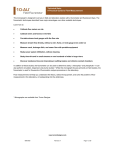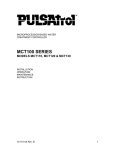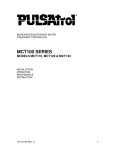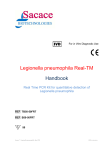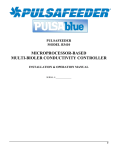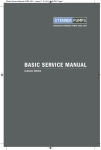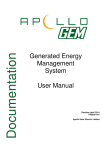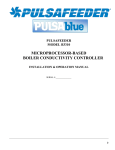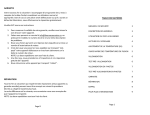Download Recommendations For Generic Cooling Tower Disinfection
Transcript
Practical Recommendations for Cooling Tower Disinfection “The risk of acquiring legionellosis (the clinical term for Legionnaires’ disease) from waterborne aerosol inhalation exposures is now the most significant waterborne-disease risk associated with drinking water in the United States.” …. Joseph A. Cotruvo, PhD, Journal of the American Water Works Association One of the greatest remaining water-related threats to human health in the United States is Legionella. Recent headlines highlighted the danger of Legionella exemplified by deaths and illness in New York City. This has led to legislation in New York City and New York State requiring registration, inspection and, in cases where Legionella is discovered, disinfection of cooling towers. Concern over the threat of Legionella is leading to heightened concern and activity nationwide. Legionella is a thermophilic bacterium that lives in a biofilm attached to the walls of hot water systems. Biofilm is a colony inhabited by many types of organisms adhered to the walls and protected by a polysaccharide adhesive secreted by certain bacteria. The protection of the polysaccharide adhesive prevents many types of disinfectant from penetrating the biofilm to kill pathogenic organisms. From time to time microorganisms escape from the biofilm or biofilm sloughs off and is carried away by the flowing water. This clump of organisms including Legionella can then be aerosolized and later inhaled by humans. Especially for people with compromised immune systems the resulting disease may be fatal. Because of the protection of the biofilm most disinfectants are ineffective at removing established biofilm. Chlorine dioxide exists in water as a dissolved gas, therefore, it can penetrate biofilm and kill the underlying bacteria. A purge of the system after treatment with chlorine dioxide will then remove the dead biofilm. Ongoing treatment using chlorine dioxide at very low doses can prevent subsequent regrowth of the biofilm and kill any free-floating Legionella in the water. Historically the major barrier to the widespread use of chlorine dioxide was the fact that chlorine dioxide was unstable and had to be generated near the point of use. Recently CDG Environmental introduced Solution 3000, transportable aqueous solution of chlorine dioxide that can be shipped and stored in polyethylene containers for use as needed with no mixing and no generator required. Solution 3000 contains 3000 ppm of pure chlorine dioxide in pure water. It can be applied as needed using just a chemical feed pump. No mixing and no generator are required. Dose control is as simple as a chemical feed pump. The following are recommendations for disinfection of a typical open loop cooling tower using Solution 3000. These recommendations are based on limited testing of a particular cooling tower as well as CDG Environmental’s experience with other cooling towers. Because every cooling tower operates differently with respect to a number of parameters and environmental variations, these recommendations should not be interpreted as authoritative but simply as guidelines to be tested on a particular tower. Efficacy of disinfection should be tested regularly and the process should be adjusted accordingly. Dosing Solution 3000 should be added to the system by injection into the water circulation stream just downstream of the circulation pump or pumps. In cases where there are multiple pumps, it will be necessary to either inject the Solution 3000 into a common line after the outlets of the pumps come together or to inject into the outlet of each pump. Solution 3000 should be injected into the water line using a “quill” that injects the Solution 3000 into the center of the flowing stream of water in the pipe. An alternative is to add solution 3000 into the basin or sump from which the pumps draw water. If this approach is taken, be sure to add solution into a well-mixed part of the sump and add the solution below the water surface. Definition of “Dose”- When this document refers to “dose” it means the concentration that would result from uniformly mixing the entire volume of applied Solution 3000 with the total water volume of the cooling tower. The actual concentration of chlorine dioxide and the duration of the dose required in the water depends upon many variables such as 1. rate at which Solution 3000 is injected, 2. the rate of water circulation, 3. chlorine dioxide demand from contaminants or chemicals in the water before injection, 4. temperature of the water, 5. the rate at which chlorine dioxide is removed from the water by contact with air in the fill, and 6. other factors CDG recommends that the tower be treated after sundown if possible. It is not necessary to wait until after sundown for disinfection. However, in towers that are open to light, exposure to sunlight breaks down chlorine dioxide. The dose will be more effective if it is not exposed to sunlight. Also ambient temperatures and heat load on the cooling tower are often lower after sundown so loss of chlorine dioxide to air will usually be slower. Chlorine dioxide is readily stripped out of water solution by contact with air. So within the constraints of operational requirements, care should be taken to minimize contact of Solution 3000 with air and minimize the amount of contact between air and the treated water that still contains chlorine dioxide. For example, if it is possible, treatment of the tower should be done with water circulating but air fans turned off. Also if injecting Solution 3000 into a basin or sump, take care to inject the solution below the surface of the water. Solution 3000 should be injected over a period of 1 to 3 hours using a chemical feed pump and the water dosed with chlorine dioxide should be circulated for at least two hours after injection is complete. A good checkpoint is to measure whether chlorine dioxide residual exists in the basin at least near the end of the Solution 3000 injection. A residual even as low as 0.1 ppm may be effective. However this is just a checkpoint, the real proof of efficacy is in measurement of the biological content of the circulating water. Initial Cleanout (note: if the cooling tower is clean because of recent cleanout this initial cleanout step may be skipped). An initial dose of 3-50 ppm should be used to clean out established biofilm. The required dose has a very wide range depending on how fouled the system is and many of the variables listed above. Depending on the degree to which biofilm exists, substantial amounts may slough off of surfaces during and soon after initial treatment. These should be flushed out with the treated water. Drain and rinse all water lines and surfaces thoroughly with clean water before starting the system again. Ongoing disinfection To prevent the regrowth of biofilm, treat the system three times per week with a dose of about 0.3-3.0 ppm. The treatment frequency of three times a week is based on experience of some current users. It may vary seasonally and depend on many other variables. The required frequency of dosing may be considerably less than this recommendation, especially if chlorine dioxide is used with other disinfectants. The cooling tower operator should test for the efficacy of disinfection and adjust the process in order to achieve disinfection objectives Test the system regularly for Legionella and other bacteria using standard biological testing procedures and adjust chlorine dioxide dosing according to the results. Pumps There are a number of pump manufacturers who produce state-of-the-art chemical feed pumps. These pumps come in two basic types, diaphragm and peristaltic, each with its own strong points and drawbacks. Diaphragm pumps - a number of manufacturers make chemical feed pumps that are based on a diaphragm operated by a solenoid. Manufacturers include LMI, Prominent, Iwaki, Pulsafeeder and others. Pumps used on Solution 3000 should have wetted parts made of Kynar (PVDF) or other fluoropolymers and seals should be Viton. Diaphragm pumps are preferred by many users because they do not require frequent replacement of any parts. However for intermittent applications they often suffer from loss of prime during start and stop operation. Loss of prime is a result of air leaks in the suction lines leading into the pump and possible air accumulation in the lines. It is possible to control these leaks but it is very difficult to detect and seal such leaks. Special care should be given to eliminate leaks on the suction side of all diaphragm pumps. Minimize the number of fittings and connections. And use special care in the application of Teflon tape to the threads. Tubing on the suction side of the pump should be PVA Teflon material so compression fittings seal better. Peristaltic pumps - two manufacturers, Stenner and Prominent, are the primary suppliers of peristaltic pumps for chemical feed applications. In specifying such pumps be sure that all wetted parts are made of Kynar (PVDF) and all seals are Viton elastomer. The key feature of peristaltic pumps is a flexible tube that does the pumping. For Stenner pumps used on Solution 3000 the material of the tube must be Santoprene. For Prominent peristaltic pumps used on Solution 3000 the tube must be made of Norprene. The drawback of peristaltic pumps is the life of the tube. CDG has operated both Stenner and Prominent peristaltic pumps on Solution 3000 for a tube life of 600 to 900 hrs. based on continuous use at 100% capacity. Stenner tubes lasted a bit longer than Prominent tubes but the difference may have been just statistical variability. For intermittent use CDG recommends changing the tube at one-month intervals. Our experience is that when tubes do fail, they start with a tiny pinhole leak or crack which causes condensation on the tube housing. This may be evident before there is a smell or even any liquid seen around the tube. It is unlikely that the tube will have a gross leak causing the pump to operate and pump Solution 3000 at high rates into an area where it is operating. For applications where the pump will be operated intermittently with unattended operation, CDGE recommends peristaltic pumps. However attention must be paid to regular change-out of the tubes. Mounting the pump The chemical feed pump should be mounted as close to the top of the drum as reasonably possible. Special care should be given to the elevation of the pump above the top of the drum. The pump should not be mounted lower than the top of the drum because that might result in siphoning if a line were broken, but the pump should be no higher than it must be above the top of the drum because increased elevation increases the leakage of air into the suction side of the pump. This is especially a problem with diaphragm type pumps since it can cause loss of prime. With peristaltic pumps a little air in the suction of the pump is not a problem, however a significant amount of air changes the pump rate. Tubing and tube fittings All tubing should be Kynar (PVDF) or Teflon (PVA). It is important to use (PVA) and not hard Kynar (PVDF) on the suction side of a chemical feed pump because soft tubing seals better with compression fittings. All tube fittings should be Kynar. Rigid piping All rigid piping should be schedule 80 CPVC. Schedule 80 PVC is acceptable but some sources say that CPVC is better. Piping joints should be glued where possible. Threaded joints with Teflon tape sealant are acceptable where necessary but are more prone to leaking than glued joints. Do not use liquid or paste sealants. Note: for tubing on the suction side of the pump, use compression fittings or glued joints. Avoid threaded joints where possible. Minimize the number of joints between the drum and the pump since joints are the source of most air leaks which can cause loss of prime. Air may leak into the suction side of the pump even if the lines do not show any signs of leak during pressure tests. Drum connections CDGE strongly recommends the use of a Colder Products Corporation system for connecting the pump to the 55 gallon drum. This will minimize the contact between operators and chlorine dioxide and reduce the effort required to connect the drum. CDGE can supply drums of Solution 3000 with preinstalled dip tubes designed to work with the Colder fittings so connection and disconnection can be accomplished with minimal effort and vented chlorine dioxide. More information on Colder systems and connections including diagrams and part numbers is included in CDGE user manual.





